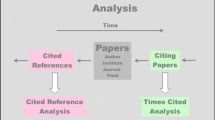Abstract
A recurring theme in the use of science and technology indicators, as well as in the construction of new ones, is the interpretation of these indicators. Given the dependence on citation data in the majority of interesting science and technology indicators, a general citation theory would make the meaning of S&T indicators more transparent. Hence the continuing call for a citation theory in scientometrics. So far, such a theory has not yet been accepted by the experts in the field. This paper suggests an explanation for this. It also tries to sketch the outline of a generalindicator theory by discussing new implications of an earlier proposal (Wouters, 1998) in relation to existing citation and indicator theories.
Similar content being viewed by others
References
Ashmore, M. (1989),The reflexive thesis: Wrighting sociology of scientific knowledge., The University of Chicago Press.
Bateson, G. (1980),Mind and Nature, Bantam, New York.
Brand, S. (1987),The Media Lab. Inventing the future at M.I.T., Penguin Books, New York.
Chubin, D., Hackett, E. J. (1990)Peerless Science: Peer review and U.S. science policy, State University of New York Press, Albany, US.
Cozzens, S. (1981), Taking the measure of science: A review of citation theories,International Society for the Sociology of Knowledge Newsletter 7(1–2), 16–20.
Cozzens, S. (1985), Comparing the sciences: Citationcontext analysis of papers from neuro-pharmacology and the sociology of science.Social Studies of Science 15, 127–153.
Cozzens, S. (1989), What do citations count? the rhetoric-first model,Scientometrics 15, 437–447.
Cozzens, S. E., Healy, P., Rip, A., Ziman, J. (1990),The research system in transition, Kluwer, Dordrecht.
Cronin, B. (1981), The need for a theory of citing,Journal of Documentation 37(1), 16–24.
Cronin, B. (1984),The Citation Process. The role and significance of citations in scientific communication, Taylor Graham, London.
Cronin, B. (1988), The sovereign sign: citations and the market for symbolic capital. Paper presented at an International Conference, Semiotics and the Information Sciences, Victoria College, University of Toronto, October 13–15, 1998.
Edge, D. O., Mulkay, M. J. (1976),Astronomy Transformed: The Emergence of Radio Astronomy in Britain, Wiley, New York.
Elkana, Y., Lederberg, J., Merton, R. K., Thackray, A., Zuckerman, H. (1979),Toward a Metric of Science: The Advent of Science Indicators, John Wiley & Sons, New York.
Gilbert, N. G. (1977), Referencing as persuasion,Social Studies of Science 7, 113–122.
Hoyningen-Huene, P. (1993),Reconstructing scientific revolutions, the University of Chicago Press.
Jasanoff, S. (1990),The fifth branch: Science advisers as policymakers, Harvard University Press, Cambridge, MA.
Kaplan, N. (1965), Prolegomena to the footnote,American Documentation, 16, 179–187.
Knorr-Cetina, K. (1981),The manufacture of knowledge: An essay on the constructivist and contextual nature of science. Pergamon, Oxford.
Latour, B. (1984),Les Microbes: Guerre et Paix suivi de Irréductions, Editions A. M. Métaillié.
Latour, B., Woolgar, S. (1986),Laboratory Life: The Construction of Scientific Facts, 2nd edn, Princeton University Press.
Lemaine, G., Macleod, R., Mulkay, M., Weingart, P. (1976),Perspectives on the Emergence of Scientific Disciplines, Mounton-Aldine, The Hague.
Leydesdorff, L. (1987), Towards a theory of citation,Scientometrics 12, 287–291.
Leydesdorff, L., Wouters, P. Eds (1997),Proceedings of the Erasmus Workshop on Quantitative Approaches to Science & Technology Studies, May 21–24, 1996, Amsterdam (The Netherlands), Vol. 38.
Luukkonen, T. (1990), Citations in the rhetorical, reward and communications systems of science, PhD thesis, Acta Universitatis Tamperensis, ser A, vol. 285, University of Tampere, Tampere.
Luukkonen, T. (1997), Why has Latour's Theory of Citations been Ignored by the Bibliometric Community? Discussion of Sociological Interpretations of Citation Analysis,in Leydesdorff & Wouters (1997), pp. 27–39.
Macroberts, M. H., Macroberts, B. R. (1984), The negational reference: or the art of dissembling,Social Studies of Science 14, 91–94.
Macroberts, M. H., Macroberts, B. R. (1989), Problems of citation analysis: A critical review,Journal of the American Society for Information Science 40(5), 342–349.
Merton, R. K. (1973),The normative structure of science, University of Chicago Press, chapter 2.
Narin, F. (1976),Evaluative Bibliometrics, Computer Horizons Inc., Cherry Hill, N.J.
Newell, A., Simon, H. A. (1990), Computer science as empirical enquiry: Symbols and search, InM. Boden, Ed., The Philosophy of Artifical Intelligemence', Oxford Readings in Philosophy, Oxford University Press, Oxford, pp. 105–133.
Porter, T. M. (1995),Trust in numbers. The pursuit of objectivity in science and public life, Princeton University Press.
Price, D. De Solla (1961),Science since Babylon, Yale University Press, New Haven.
Price, D. De Solla (1970), Citation measures of hard science, soft science, technology and non-science, D. C. Health & Co, Lexington, Mass., pp. 3–22.
Price, D. De Solla (1979), The citation cycle, In The American Society for Information Science, 8th Mid-Year Meeting, May 16–19, 1979 Collected Papers.
Shannon, C. E., Weaver, W. (1949),The Mathematical Theory of Communication, The University of Illinois Press, Urbana.
Smith, L. C. (1981), Citation analysis,Library Trends pp. 83–106.
Van Der Meulen, B. J. R. (1992), Evaluation Processes in Science: the Construction of Quality by Science, Government and Industry, PhD thesis, University of Twente.
Whitley, R. (1984),The intellectual and social organization of the sciences, Oxford University Press.
Wouters, P. (1997), Citation cycles and peer review cycles, InLeydesdorff & Wouters (1997), pp. 39–55.
Wouters, P. (1988), The signs of science,Scientometrics 41 (1–2), 225–241.
Wouters, P. (1999), The Citation Culture, PhD thesis, Science and Technology Dynamics, University of Amsterdam.
Author information
Authors and Affiliations
Rights and permissions
About this article
Cite this article
Wouters, P. Beyond the holy grail: From citation theory to indicator theories. Scientometrics 44, 561–580 (1999). https://doi.org/10.1007/BF02458496
Received:
Issue Date:
DOI: https://doi.org/10.1007/BF02458496




